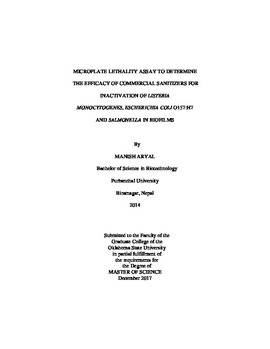| dc.contributor.advisor | Muriana, Peter M. | |
| dc.contributor.author | Aryal, Manish | |
| dc.date.accessioned | 2018-06-25T16:31:12Z | |
| dc.date.available | 2018-06-25T16:31:12Z | |
| dc.date.issued | 2017-12-01 | |
| dc.identifier.uri | https://hdl.handle.net/11244/300281 | |
| dc.description.abstract | The prevalence of biofilms in food industries has caused serious problems. Different micro-organisms have been found to cross contaminate product itself, equipment and processes in food industries. Though various physical and biological methods have been applied to eliminate biofilms in food industries, chemical methods are still the most common and cost effective ways of biofilm prevention.The objective of this study was to determine efficacy of commercial sanitizers for inactivation of L. monocytogenes, E. coli O157:H7 and Salmonella in biofilms. L. monocytogenes, E. coli O157:H7 and Salmonella spp. were grown in black 96-well microplates and incubated with a fluorescent substrate (5,6-CFDA) to assess the degree of adherence or determine relative fluorescence unit (RFU) values with the help of fluorescent plate reader. Secondly, 7-day old biofilms of the adherent strains were grown in 96-well clear microplates and incubated for an hour at 37º C with different concentrations of enzymes. The recovered cells were then enumerated by plating on TSA plates to evaluate detaching ability of enzymes. Lastly, the 7-day old biofilms were treated with commercial sanitizers at various concentrations for different time periods in 96-well microplates. The reduction in number of cells was quantified by enzymatic detachment and plate counts and qualitatively assessed via scanning electron microscopy (SEM). Repeated Measures (RM) One-Way ANOVA was carried out to see significant differences (p<0.05) in the response of different organisms to sanitizer treatment. L. monocytogenes 99-38, E. coli O157:H7 F4546 and Salmonella Montevideo FSIS051 were screened as the adherent strains and Trypsin (426.4 U/ml) was determined as a potent enzyme to detach the cells in biofilms. Among the commercial sanitizers, Decon7 (10%) sanitizer mix was found to be the most effective one as just 1 min of treatment with it reduced L. monocytogenes 99-38 and E. coli O157:H7 F4546 biofilms below limit of detection (2 log CFU/ml) and reduced >7 log CFU/ml of Salmonella Montevideo FSIS051 in just 2.5 minutes of treatment.Thus, the application of new sanitizers (based on combination of several components) followed by enzymatic treatment may be the best option to kill and remove dead biofilms in food processing facilities. | |
| dc.format | application/pdf | |
| dc.language | en_US | |
| dc.rights | Copyright is held by the author who has granted the Oklahoma State University Library the non-exclusive right to share this material in its institutional repository. Contact Digital Library Services at lib-dls@okstate.edu or 405-744-9161 for the permission policy on the use, reproduction or distribution of this material. | |
| dc.title | Microplate Lethality Assay to Determine the Efficacy of Commercial Sanitizers for Inactivation of Listeria Monocytogenes, Escherichia coli O157:H7 and Salmonella in Biofilms | |
| dc.contributor.committeeMember | Ramanathan, Ranjith | |
| dc.contributor.committeeMember | Jadeja, Ravirajsinh | |
| osu.filename | Aryal_okstate_0664M_15513.pdf | |
| osu.accesstype | Open Access | |
| dc.description.department | Animal Science | |
| dc.type.genre | Thesis | |
| dc.type.material | text | |
